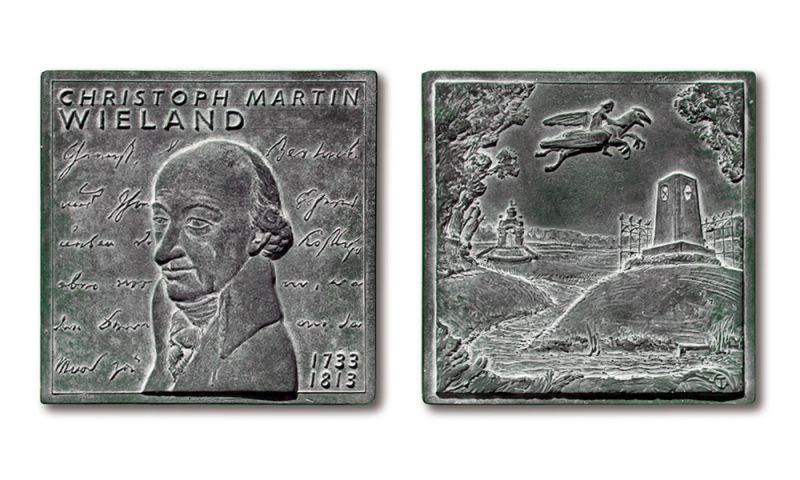
text: Carsten Theumer
The Wieland medal
The medal was created in 2013 to commemorate the 200th anniversary of the death of poet Christoph Martin Wieland. Wieland was born in Oberholzheim near Biberach on 5 May 1733 and died in Weimar on 20 January 1813. He was one of the most important writers of the Enlightenment in the German-speaking world and one of the four representatives of Weimar Classicism, along with Goethe, Schiller and Herder the Elder.
The front shows a semi-profile portrait of Wieland based on existing portraits from his later years. The text in the background is a transposition of Wieland’s handwriting, taken from the first lines of a letter to publisher Friedrich Justin Bertuch dated 20/10/1811.
The idea for the back of the medal came to me immediately after visiting the
Wieland memorial in Ossmannstedt, near Weimar.
Wieland purchased the estate with its huge garden in 1797; it was the centre of the lives of Wieland and his family until 1803.
Many important poets and friends of the family stayed here during this period.
The back of the medal shows a topographically condensed view of the romantic park in Ossmannstedt, which still allows us to experience the artistic intentions of Wieland’s times today. The bubbling fountain in the upper part of the park has been connected to Weiland’s grave in the lower part near the bend in the river Ilm. Here, the water’s path not only shows where the garden starts and ends; its cycle, as an element of life, also bears witness to our constant growth and decay.
I visited the museum with my wife in the summer of 2012, after which we walked through the park towards Wieland’s grave, where we were suddenly surprised by a huge shadow soaring over the tops of the old beech trees. Even though we couldn’t make out any details, we both immediately agreed that it could only have been the poet’s ghost. In that moment, the garden worked its magic on us.
I therefore added the image of a rider on a flying hippogryph to the medal.
To Wieland, the hippogryph, like Pegasus, was a symbol of poetic art.
At the same time, the image is a reference to the first lines of the First Song of Wieland’s epic poem Oberon from 1780:
“Saddle the hippogryph for me once more, oh muses,
that I may ride into the old romantic land!...”
Author’s translation. Source text:
“Noch einmal sattelt mir den Hippogryphen, Ihr Musen, Zum Ritt ins alte romantische Land!....”